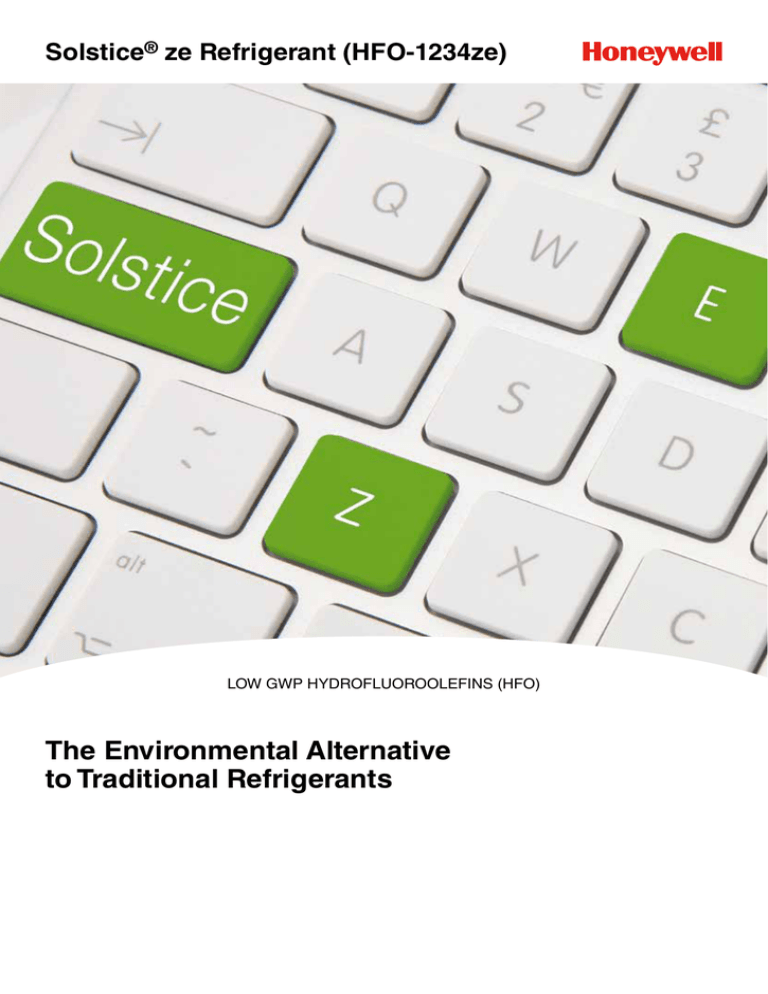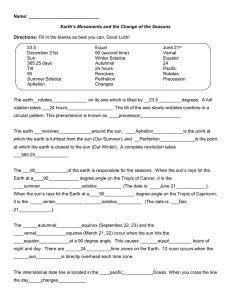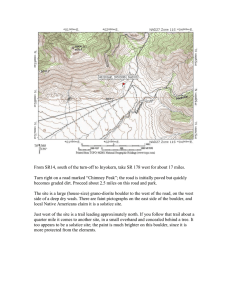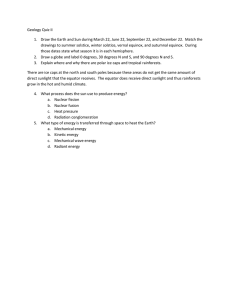
Solstice® ze Refrigerant (HFO-1234ze)
LOW GWP HYDROFLUOROOLEFINS (HFO)
The Environmental Alternative
to Traditional Refrigerants
Fourth Generation Refrigerants for the 21st Century
Honeywell has been at the forefront of every major
development of fluorocarbon refrigerants technology.
As the world seeks new, lower-global-warmingpotential solutions, Honeywell delivers again, with its
Solstice® brand of hydrofluoroolefins (HFOs), a family
of unique products that offer comparable performance
to today’s most widely-used stationary and mobile
refrigerants, blowing agents and aerosol propellants.
However, unlike their more common counterparts, the
molecular structure of Solstice products causes them
to have short atmospheric lifetimes, which means they
have very low global warming potential (GWP) index.
Honeywell’s Solstice brand reflects the products’
break-through environmental properties, including
their insulating capabilities for foam and their superior
cooling capabilities for automotive air conditioning
and stationary refrigerant applications.
Hydrofluoroolefins (HFOs): who is who
The chemical structure of pure fluids such
as Solstice® ze, Solstice® yf and
Solstice® zd contains a carbon-carbon
double bond which is a key feature
facilitating the low global warming
characteristic. These molecules also have
low atmospheric lifetimes.
Solstice® ze is trans-1,3,3,3-tetrafluoroprop1-ene to which ASHRAE Standard 34 has
assigned the nomenclature of R-1234ze(E).
The suffix (E) indicates that it is an isomer.
The other isomer (suffix (Z)) is cis-1,3,3,3tetrafluoroprop-1-ene. The physical
properties of the (E) and (Z) isomers are
Physical properties
Solstice® ze (HFO-1234ze)
Chemical Name
trans-1,3,3,3-Tetrafluoroprop-1-ene
Molecular Formula
CF3CH=CHF
Appearance
Colourless
Ozone Depletion Potential (ODP-R11=1)
0
Global Warming Potential rev 5th IPCC
(GWP CO2=1)
<1
ASHRAE Std. 34 Safety Classification
A2L
Flammability Limits – ASTM E681-04 @ 21ºC
Non Flammable
Flammability Limits – ASHRAE 34 @ 100ºC
7% – 12% (by volume)
Units
Molecular weight
Boiling point at 101.3 kPa
Freezing point at 101.3 kPa
Critical temperature
Critical pressure
The HFO-1234ze isomers:
SI
-18.95°C
-156°C
109.4°C
36.36 bar
0.00204 m3/kg
Critical density
489 kg/m3
Vapour density at boiling point
5.71 kg/m3
Liquid density
1293 kg/m3
Liquid heat capacity at 25°C
1.383 kJ/kg °K
Vapour heat capacity at 25°C
0.9822 kJ/kg °K
Vapour pressure at 25°C
195.4 kJ/kg
498.6 kPa
Liquid thermal conductivity at 25°C
0.0781 W/m °K
Vapour thermal conductivity at 25°C
0.0136 W/m °K
Liquid viscosity at 25°C
199.4 μPa sec
Vapour viscosity at 25°C
12.2 μPa sec
% Volatiles by volume
Solubility of HFO-1234ze(E) in water
HFO-1234ze(E)
114 kg/mol
Critical volume
Heat of vaporisation at boiling point
different: both are ultra-low GWP molecules
with GWP<1, but R-1234ze(Z) has a high
boiling point (9.8°C) associated with a
higher critical temperature (153.7°C) and
a volumetric capacity roughly 50% lower
than R-1234ze(E), which makes it not the
best option as replacement of 134a. Even
if the properties of R-1234ze(Z) could be
utilised in specific applications like high
temp heat pumps, R-1234ze(E) will show
operating conditions and applied costs
much more in line with R-134a according to
system and compressor sizes.
100
0.037 wt.%
HFO-1234ze(Z)
H
F
C
CHILLERS
COMMERCIAL AC
Pressure and temperature
35
668
40
767
45
876
50
997
55
1131
60
1277
65
1437
70
1611
30
40
50
T + 273.15 + A1
A0 = -1115.58
with
60
70
80
90
100
(oC)
A0
log10 (Press) =
+A2
(bar, ºC)
A1 = -6.78
A2 = 4.52
HFO-1234ze
Pressure and enthalpy
45
40
35
30
28
26
24
22
20
18
16
14
Pressure
(bar)
Pressure
(bar)
Leak detection
20
Temperature
Leaks
If a large release of Solstice® ze vapour
occurs, the same measures as with R-134a
need to be taken.
10
12
90ºC
578
0
95ºC
30
-10
100ºC
499
-20
85ºC
427
25
-30
80ºC
20
0
-40
75ºC
364
65ºC
308
15
60ºC
10
500
70ºC
259
55ºC
216
5
50ºC
0
1000
45ºC
179
40ºC
147
-5
35ºC
-10
1500
30ºC
120
105ºC
0.200 g/cc
110ºC
1.100 g/cc
-15
2000
25ºC
97
20ºC
-20
5ºC
77
15ºC
-25
2500
0ºC
61
10ºC
-30
1.200 g/cc
48
-5ºC
-35
3000
-10ºC
37
-20ºC
-15ºC
-40
3500
1.300 g/cc
Pressure (absolute)
kPa
Pressure (kPa)
Temperature
ºC
10
9
8
7
6
5
Hand-held leak detectors can be used for
4
pinpointing leaks. For monitoring an entire
room on a continual basis, leak monitors
3
are available. Leak detection is important
for protection of those in proximity of
2
the system, refrigerant conservation,
equipment protection and performance,
and reduction of emissions. Customers
1
should consult the equipment manufacturer
160
for appropriate detectors.
Reference State:
`
180
200
220
h = 200 kJ/kg, s = 1.00 kJ/kg-K
Reference State:
sat. liq at 0 ºC
240
260
280
300
320
340
360
380
400
Enthalpy (kJ/kg)
Enthalpy
(kJ/kg)
h=200 kJ/kg, s=1.00 kJ/kg-K sat. liq. at 0oC
420
440
460
480
500
520
540
560
Materials compatibility
Honeywell does not recommend the use of
chlorinated solvents to clean refrigeration
systems or components.
Plastics and elastomers
Solstice® ze is compatible with most
common materials. Since there are many
different grades and formulations of these
materials, we recommend that compatibility
testing be performed on the specific grade
of materials under consideration and at
the conditions of use when designing new
systems.
The table below contains materials
compatibility data resulting from tests
performed by Honeywell (testing
conditions: two weeks liquid immersion at
Avg. % change in
hardness
Substrate
Avg. % change in
weight
Avg. % change in
volume
ABS
0.21
-0.6
Delrin® Acetal
0.18
0.48
HDPE
0.82
-3.74
NYLON 66
-0.26
0
1.1
0.77
Extremely distorted
Acrylic
Polycarbonate*
-0.04
0
0.21
0
Teflon®
2.03
2.43
Polypropylene*
0.83
0
HIPS
0.26
-0.45
PVC-TYPE 1
0.002
-0.44
Polyetherimide
PET
SBR/CR/NBR
7.28
-0.01
0
2
-4.31
-11.29
4.43
5.71
Buna-Nitrile
8.91
-4.95
-7.18
EPDM
-1.5
-2
-2.49
Viton® B COMM. GRADE
Epichlorohydrin
-3.5
0.73
1.51
Silicone*
-0.71
-1.57
-1.96
Natural Rubber (Gum)
2
-0.64
-0.75
Texin® (Thermoplastic)
Polyurethane 390
-4.35
5.14
4.41
Butyl Rubber
-1.13
1.27
0.88
7.32
-7.7
-11.47
-10.36
5.22
33
Neoprene
Kalrez® 6375
Suitable
Suitable under certain conditions
Unsuitable
Desiccants
Desiccant driers compatible with
Solstice® ze are commercially available.
Individual drier manufacturers should be
contacted for specific recommendations.
Lubricants
POE (polyol ester) oil is recommended for
using Solstice® ze.
As most of the ultra-low GWP refrigerants,
Solstice® ze is more miscible and more
soluble in oil than traditional HFCs or
Comments
Pitted after 1 week. Expands
Kynar® PVDF*
ULTEM®
room temperature). This data should be
used only as a guide to the compatibility of
materials with Solstice® ze. The rankings
in the table should be used with caution
since they are judgments based on limited
samplings. Customers should consult
the manufacturer or conduct further
independent testing.
Turbid fluid after 1 week. Residue
Fluid discoloration
Turbid fluid. Residue
Slight fluid discoloration. Residue
* Although changes in weight, volume and
hardness are minimal, fluid discoloration
and/or residue suggest the material may
not be suitable for some applications.
HCFCs. When a higher miscibility is
very favourable in systems for returning
oil to compressors from the liquid side
of the circuit, a higher solubility means
that more refrigerant will be trapped in
gaseous phase in the oil sump. A direct
consequence is the reduction in working
viscosity of the lubricating mixture
(combination of lubricant and refrigerant)
to the compressor bearings. The minimum
viscosity criterion to operate under the
highest bearing loads varies depending
on compressor and bearing technology,
so there could be a need for certain
technologies and at certain conditions to
increase the viscosity of the lubricant for
compressors used with Solstice® ze
in order to maintain reliable bearing
lubrication.
Compressor manufacturers typically
qualify specific lubricants for use with
their products. Users should check with
the equipment manufacturer for the
recommended lubricants for their system.
Safety and storage
Honeywell recommends reading the
Material Safety Data Sheet (MSDS) before
using the product.
800ppm (8-hour time-weighted average).
HFC-134a, with a 1,000ppm WEEL value
is currently used in centrifugal and screw
chillers. The Solstice® ze refrigerant SDS
contains the following toxicity information:
the 4-hr acute inhalation LC50 (rat)
was >207000ppm; no skin irritation
was observed in rabbits; no cardiac
sensitisation was observed in dogs with
exposures up to 120,000 ppm; repeated
dose toxicity in rats (13-wk) found mild
effects on the heart (NOEL 5,000ppm);
in vitro genotoxicity findings include
negative Ames Test and negative human
lymphocyte chromosome aberration
test; in vivo genotoxicity findings in the
mouse micronucleus test were negative
(inhalation, mammalian bone-marrow
cytogenic test with chromosomal analysis).
Refrigerant Solstice® ze or trans-1,3,3,3tetrafluoroprop-1-ene is registered under
the European Union’s REACH program
(Registration, Evaluation, Authorisation and
Restriction of Chemicals).
Toxicity
Solstice® ze has undergone extensive
toxicity testing and when used in
accordance with applicable guidelines
and standards, is considered safe for its
intended refrigeration and air-conditioning
applications.
The Occupational Alliance for Risk Science
(OARS) WEEL value for R-1234ze(E) is
Minimum Ignition Energy (mJ)
Flammability is evaluated by ‘Chance of Flame
occurring’ and ‘Effect of Flame occurring’
100,000
R-1234ze @ 60oC
Non-flammable below 30oC
10,000
R-1234yf
1,000
10
1
0.1
g
sin ity
rea bil
Inc mma
Fla
NH3
100
x 250,000
more
energy to
ignite!
R-32
R-600a Methane
R-290
0.01
Probability of Ignition
Chance of Flame occurring:
Lower Flame Limit vs
Minimum Ignition Energy
R-152a
Gasoline
Acetylene
0 25 50 75 100 125 150 175 200 225 250 275 300 325 350
Lower Flame Limit (g/m3)
Heat of Combustion, MJ / kg
x 10 more concentration to ignite!
60
Methane
50
Gasoline
R-290
40
g
sin
rea e
Inc mag
Da
30
NH3
20
Class 2
10
R-134a
0
0
Damage Potential
Effect of Flame occurring:
Burning Velocity vs Heat of
Combustion
Class 3
R-152a
R-1234ze R-1234yf
R-600a
R-32
5
Class 2L
10
15
20
25
30
35
40
45
50
Burning Velocity, cm / s
LFL
UFL
Temperature, oC
120
100
80
60
R-1234ze Flame Limit:
US DOT & ASHRAE
40
No flame limits
below 30°C
20
0
0
5
10
Vol. % in Air
15
Flammability
According to ASHRAE Standard-2010,
Solstice® ze, R-1234ze(E) is classified
in safety group A2L, i.e., it is in the
lower segment of the mildly flammable
refrigerants.
A unique characteristic of this refrigerant is
the absence of flammable mixture with air
under 30°C of ambience. That’s why it is
non flammable for handling and storage.
When utilised in a system, R-1234ze(E)
could become flammable with air in case
of a leakage and the following chart gives
a graphical positioning of R-1234ze(E)
versus other refrigerants in the ‘chance
of flame occurring’ ranking: R-1234ze(E)
needs 10 times more concentration
and 250,000 times more energy than
hydrocarbons to become flammable, only
above 30°C.
In case of a flame occurring with
Solstice® ze, the effect of this flame would
be extremely mild, as its very low heat of
combustion (5 times less than propane)
associated to a ultra low burning velocity
wouldn’t be enough to propagate a fire.
Flammability characteristics
Upper Flammability Limit,
Vol. % in air (21°C, ASTM
E681-01)
None
Lower Flammability Limit,
Vol. % in air (21°C, ASTM
E681-01)
None
Upper Flammability Limit,
Vol. % in air (60°C, ASTM
E681-01)
5.7
Lower Flammability Limit,
Vol. % in air (60°C, ASTM
E681-01)
11.3
Minimum Ignition Energy,
mJ at 20°C and 1 atm
(Chilworth Technology)
No ignition
Minimum Ignition Energy,
mJ at 54°C and 1 atm
(Chilworth Technology)
>61,000
<64,000
Autoignition Temperature,
°C (EC Physico/Chemical
Test A15, Measured by
Chilworth Technology,
UK)
368
Heat of Combustion, MJ/
kg per ASHRAE Standard
34 (Stochiometric
composition 7.73% in air)
10.7
Fundamental burning
velocity, cm/s (per ISO
817, Measured by AIST,
Japan)
0 (no flame
propagation)
PED
PED is a European directive and not an
industry standard like ISO5149 or EN378.
When refrigerant classification for industry
standards refers to ISO817 or ASHRAE34,
it is based on EU definition for PED (or any
European directive classification).
PED has two fluid groups, hazardous and not
hazardous. Flammable are in the hazardous
group and the PED define flammability
according to A11 method from European
Regulation EC 440/2008. This flammability
test is done at 21°C so under EU A11,
Solstice® ze is not flammable and does not
flash, therefore it is group 2. Honeywell duly
registered R-1234ze under REACH at the
highest tonnage tier and the classification,
as submitted to the European Chemicals
Agency (ECHA) is reported in the Producer’s
Safety Data Sheet (SDS): therefore R-1234ze
(trans-1,3,3,3-Tetrafluoroprop-1-ene)
properties correspond to that of PED group 2.
Storage and handling in bulk
and cylinder
Solstice® ze has similar storage and
handling requirements to 134a, since
according to the compressed gas
classification it is nonflammable.
Solstice® ze cylinders must be clearly
marked and kept in a cool, dry and
properly ventilated storage area away from
heat, flames, corrosive chemicals, fumes,
explosives – and be otherwise protected
from damage.
Under no circumstances should an empty
cylinder be refilled with anything other
than virgin product. Once empty, properly
close the cylinder valve and replace the
valve cap. Return empty cylinders to
your Honeywell distributor. Cylinders of
Solstice® ze should be kept out of direct
sunlight, especially in warm weather.
Liquid Solstice® ze expands significantly
when heated, reducing the amount of
vapour space left in the cylinder. Once the
cylinder becomes liquid-full, any further
rise in temperature can cause it to burst,
potentially resulting in severe personal
injury. Never allow a cylinder to get warmer
than 52°C.
Vessels, containers, transfer lines, pumps
and other equipment used with
Solstice® ze should not be exposed to
high-temperature sources (such as welding,
brazing and open flames) until they have
been thoroughly purged and confirmed free
of vapours or liquid. Cylinders must never
be exposed to welding, brazing or open
flames. When possible, maintenance or
cleaning of equipment should be performed
without entering the vessel. If a tank or
any confined space must be entered, then
formal confined space entry procedures
must be followed. These procedures require
that a fully qualified work team be used
and that applicable confined space entry
documentation be completed.
Applications
Honeywell’s new Solstice® ze refrigerant
(HFO-1234ze) is the best medium pressure,
low GWP refrigerant on the market when
considering the balance of all properties.
It is an energy-efficient alternative to
traditional refrigerants in different medium
temperature uses and has been selected
by a number of equipment manufacturers
for applications with a capacity range from
several kW to 20MW and charges varying
from 300g to 13mT:
Once the design of the application has
been optimised to match capacity of
HFC-134a, the advantage of Solstice® ze
is higher energy efficiency or Coefficient
of Performance (CoP) than 134a across
a range of applications and conditions.
According to compressors experts,
performance with HFOs can be further
improved with optimisation of compressor
design. Reciprocating, scroll, screw and
centrifugal compressors can be used.
• Air-cooled and water-cooled chillers
Other features of Solstice® ze:
• District heating and cooling
• As Solstice® ze is a pure molecule it can
be used in flooded systems
• Heat pumps
• Beverage dispensers
• The thermodynamic properties of
Solstice® ze may benefit from a liquidline/suction-line heat exchanger or other
cycle modifications
• Air dryers
Cost-effectiveness
• CO2 cascade systems, etc.
Fast Implementation
• Refrigerators
• Vending machines
Multi-awarded by the industry, Solstice® ze
meets the criteria that are most important
to refrigerants users: Performance, Cost
Effectiveness, Environmental Impact and
Safety.
Performance
Field tests of air-cooled chillers in similar
systems comparing Solstice® ze with
propane (R-290) show significantly
lower energy consumption. In addition,
compared to traditional refrigerants, the
properties and operating characteristics
of Solstice® ze are a very good match, but
without the environmental penalty of high
GWP HFCs.
Solstice® ze exhibits similar performance to
medium-pressure refrigerants like 134a, so
only minor considerations are required to
use Solstice® ze.
Longer life of compressors
Solstice® ze Refrigerant lower discharge
pressure results in less mechanical stress,
thus extending the life of the compressor.
Energy Efficiency
Solstice® ze is more energy efficient
in hot regions than competitive LGWP
alternatives for this type of equipment.
Global Solution
Solstice® ze refrigerant provides efficient
cooling in all global climate zones and is
commercially available. Honeywell has
invested in adding commercial-scale
production capability of HFO-1234ze.
Environmental impact
Solstice® ze has a GWP of <1, exceeding
existing climate protection goals.
• Helps with eco-design directives
• Reduces direct CO2 emissions by
99.6 percent
• Reduces indirect CO2 emissions due to
the lower energy consumption
• Atmospheric life is only 18 days, much
lower than the 13 years of 134a.
Safety
Solstice® ze Refrigerant is significantly
safer in use than alternatives such as
hydrocarbons and ammonia, which are
either extremely flammable or highly toxic.
Atmospheric Decomposition of
Solstice 1234ze
HFO-1234ze(E) breaks down into the
same by-products of other commonly
used fluorinated compounds at levels
much lower than naturally present. F atoms
degrade into HF which is then rained out
and mineralised with no additional effect on
Ozone or on Climate*.
* “We conclude that the products of the atmospheric oxidation
of trans-CF3CH=CHF will have negligible environmental
impact”, M.S. Javadiet. al. ; Atmospheric Chemistry of
Trans-CF3CH=CHF” in Atmospheric Chemistry & Physics
Discussions,Vol8, pp 1069-1088, 2008
Comparison 134a alternatives
ASHRAE class
GWP (rev 5th IPCC)
134a
1234ze
CO2
R-600
R-290
A1
A2L
A1
A3
A3
1300
<1
1
3
3
LFL (vol% in air)*
N/A
7% **
N/A
1.80%
2.10%
UFL (vol% in air)*
N/A
12% **
N/A
8.40%
9.50%
Heat of Combustion
(kJ/g)
4.2
10.7
N/A
45.6
46.3
Burning Velocity (cm/s)
N/A
N/A
N/A
41
46
Minimum Ignition
Energy (mJ)
N/A
61000 to 64000 ***
N/A
~0.25
0.25
PED (97/23/EC) class
2
2
2
1
1
Flammability for
handling and storage
No
No
No
Yes
Yes
Commercial availability
Yes
Yes
Yes
Yes
Yes
Ease of adoption
Baseline
Moderate – Easy
when systems can
be designed
Difficult – Very
sophisticated
systems
Difficult –
Flammability
issues limit charge
amounts
Difficult –
Flammability
issues limit charge
amounts
Cost of adoption
Baseline
Moderate
High
High
High
*Flame limits- ASTM E681-04 at 21°C; **(at 100ºC); ***(at 54°C)
Degradation products of various fluorinated compounds
Fluorinated
compound
In use
In atmosphere
134a
None known (hypothetically CF2 =
CHF)
TFA, CO2, Acid gases (HF)
Minerals like Caf2
1234ze
None known (hypothetically CF3-C
= CH)
CO2, Acid gases (HF)
Minerals like Caf2
Future-proof
Package Sizes
Solstice®
Solstice® ze refrigerant is available in
890 kg rolldrum and ISO bulk. For other
packing sizes please contact Honeywell
distribution network.
ze is not subject to quota phase
down in Fgas Regulation and given its
ultra-low GWP<1, lower than the reference
value of 1 for CO2, is not subject to taxes
or fees in those countries where those
schemes apply.
Available tools
Simulation software
Smart phones apps
Honeywell’s refrigerants modelling
software is a free-download software
program that eliminates the guesswork
involved in selecting a refrigerant by
allowing refrigeration engineers to run
simulations based on actual data. The tool
runs property calculations of refrigerants,
conducts thermodynamic evaluations of air
conditioning and refrigeration cycles, and
provides a first principle thermodynamic
comparison of new alternative refrigerants
for retrofit applications or new system
designs.
Download
Honeywell PT calculation
Basics
applications for iOS and Android free
App Store Badge
Available on the
Available on the
Literature
Honeywell has a wide range of literature
available on Solstice® ze including case
references,
etc. size
The App Store badge must be studies,
used in both customers
Minimum
clear space and minimum
marketing and advertising communications, such as
TV spots, print ads, video trailers, email, newsletters,
and websites, whenever you promote your app
offered on the App Store. Only the badge shown here
is approved by Apple.
For online communications, you must provide a
link to your app on the App Store wherever the
App Store badge is used. To obtain the URL for your
app on the App Store, go to your product page in
iTunes. Right-click or Control-click your app listing
and choose Copy URL. Embed the URL in the App
Store badge or your marketing copy.
Customers will be directed to install iTunes software
if needed, then routed to their original destination
on the App Store.
Localized badges
Apple provides badge artwork with the “Available
on the” modifier translated into 11 languages (listed
below). Do not create your own version of a localized
badge. Always use artwork provided by Apple.
The software models systems from
simplified basic cycles to large, complex
refrigeration systems. The results can be
exported to Microsoft Excel, where the data
can be manipulated in a variety of ways.
The software also creates typical Mollier
diagrams (Pressure-Enthalpy, TemperatureEntropy). You can download the Genetron
Refrigerants Modelling Software at
https://www.honeywell-refrigerants.com/
europe/genetron-refrigerants-modelingsoftware-download/
The App Store badge is available in these languages:
Chinese Simplified, Chinese Traditional, Dutch, English,
French, German, Italian, Japanese, Portuguese, Russian, and
Spanish.
40 px
X
X
X
Available on the
X
X
Backgrounds
X
X Store badge always
The Available
on the App
12 px X App Store
appears in black and white as shown here. The white
X
X
border surrounding the badge is part of the badge
artwork and must be included. The App Store badge
can be placed on:
• A black or white background
• A solid-color background
• A background image as long as legibility is not
diminished
Available on the
Available on the
App Store Marketing and Advertising Guidelines for Developers
References
Information and contact
• IPCC WG AR – Chapter 8: Anthropogenic and Natural
Radiative Forcing, February 2014
• Danfoss Turbocor Mostra presentation: The TG310
compressor with ultra-low GWP refrigerant HFO-1234ze,
March 2014
• IOR (Institute of Refrigeration: R-1234ze for variable speed
centrifugal chillers, April 2013
• ‘Atmospheric Chemistry of Trans-CF3CH=CHF’ in
Atmospheric Chemistry & Physics Discussions,Vol8, pp
1069-1088, 2008
For information and support on new
applications, contact your local
Honeywell representative, visit
www.honeywell-refrigerants.com/europe
or send us an email at
fluorines.europe@honeywell.com
Delrin® is a registered trademark of the E. I. DuPont Company
Ultem® is registered trademark of the General Electric
Company
Kynar® is registered trademark of the Atofina Company
Teflon® is a registered trademark of the E. I. DuPont Company
Viton® is a registered trademark of DuPont Dow Elastomers
Texin® is a registered trademark of Bayer AG
Kalrez® is a registered trademark of the E. I. DuPont Company
• Minimum clear space is equal to one-quarter the
height of the badge.
• Do not place photos, typography, or other graphic
elements inside the minimum clear space.
• Minimum size is 10 mm for use in printed materials
and 40 pixels for use onscreen.
• Always select a size that is clearly legible but not
dominant.
March 2012
RESPONSIBLE CARE
Honeywell Performance Materials and Technologies, as a
member of the American Chemistry Council, has adopted
Responsible Care® as the foundation of health, safety,
and environmental (HS&E) excellence in our business.
Responsible Care is the chemical industry’s global voluntary
initiative under which companies, through their national
associations, work together to continuously improve their
health, safety and environmental performance, and to
communicate with stakeholders about their products and
processes.
Our commitments:
The safety of our employees
The quality of our products
Being responsible stewards for the protection of the
environment, the communities in which we operate and our
customers
Honeywell Belgium N.V.
Interleuvenlaan 15i
3001 Heverlee, Belgium
Phone: +32 16 391 212
Fax: +32 16 391 371
E-mail:fluorines.europe@honeywell.com
Please visit us at
www.honeywell-refrigerants.com/europe
FPR-003/2015-01
© 2015 Honeywell International Inc. All rights reserved.
4







